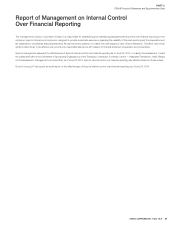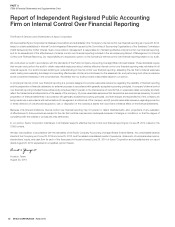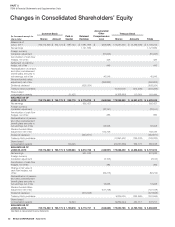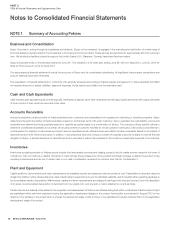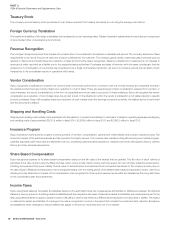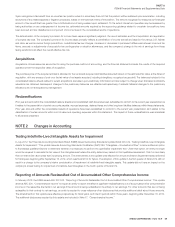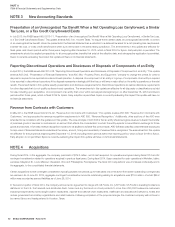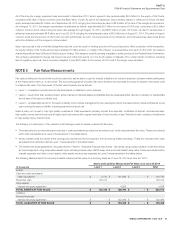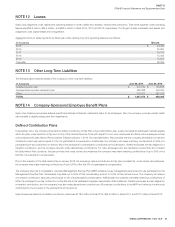Sysco 2014 Annual Report Download - page 69
Download and view the complete annual report
Please find page 69 of the 2014 Sysco annual report below. You can navigate through the pages in the report by either clicking on the pages listed below, or by using the keyword search tool below to find specific information within the annual report.SYSCO CORPORATION-Form10-K 57
PARTII
ITEM8Financial Statements and Supplementary Data
Applicable interest charges incurred during the construction of new facilities and development of software for internal use are capitalized as one of the
elements of cost and are amortized over the assets’ estimated useful lives. Interest capitalized for the past three scal years was $1.1 million in scal 2014,
$4.2 million in scal 2013 and $20.8 million in scal 2012.
Long-Lived Assets
Management reviews long-lived assets for indicators of impairment whenever events or changes in circumstances indicate that the carrying value may
not be recoverable. Cash ows expected to be generated by the related assets are estimated over the asset’s useful life based on updated projections
on an undiscounted basis. If the evaluation indicates that the carrying value of the asset may not be recoverable, the potential impairment is measured
using fair value.
Goodwill and Intangibles
Goodwill and intangibles represent the excess of cost over the fair value of tangible net assets acquired. Goodwill and intangibles with inde nite lives are
not amortized. Goodwill is assigned to the reporting units that are expected to bene t from the synergies of a business combination. The recoverability of
goodwill and inde nite-lived intangibles is assessed annually, or more frequently as needed when events or changes have occurred that would suggest an
impairment of carrying value, by determining whether the fair values of the applicable reporting units exceed their carrying values. The reporting units used
to assess goodwill impairment are the company’s 12 operating segments as described in Note 21, “Business Segment Information.” The components
within each of the 12 operating segments have similar economic characteristics and therefore are aggregated into 12 reporting units. The evaluation of
fair value requires the use of projections, estimates and assumptions as to the future performance of the operations in performing a discounted cash ow
analysis, as well as assumptions regarding sales and earnings multiples that would be applied in comparable acquisitions.
Intangibles with de nite lives are amortized over their useful lives in a manner consistent with underlying cash ow, which generally ranges from two to ten
years. Management reviews nite-lived intangibles for indicators of impairment whenever events or changes in circumstances indicate that the carrying value
may not be recoverable. Cash ows expected to be generated by the nite-lived intangibles are estimated over the intangible asset’s useful life based on
updated projections on an undiscounted basis. If the evaluation indicates that the carrying value of the nite-lived intangible asset may not be recoverable,
the potential impairment is measured at fair value.
Restricted Cash
Sysco is required by its insurers to collateralize a part of the self-insured portion of its workers’ compensation and liability claims. Sysco has chosen to
satisfy these collateral requirements by depositing funds in insurance trusts or by issuing letters of credit. All amounts in restricted cash at June 28, 2014
and June 29, 2013 represented funds deposited in insurance trusts.
Derivative Financial Instruments
All derivatives are recognized as assets or liabilities within the consolidated balance sheets at fair value at their gross values. Gains or losses on derivative
nancial instruments designated as fair value hedges are recognized immediately in the consolidated results of operations, along with the offsetting gain
or loss related to the underlying hedged item.
Gains or losses on derivative nancial instruments designated as cash ow hedges are recorded as a separate component of shareholders’ equity from
inception of the hedges to their settlement, at which time gains or losses are reclassi ed to the Consolidated Results of Operations in conjunction with the
recognition of the underlying hedged item.
In the normal course of business, Sysco enters into forward purchase agreements for the procurement of fuel and electricity. Certain of these agreements
meet the de nition of a derivative. However, the company elected to use the normal purchase and sale exemption available under derivatives accounting
literature; therefore, these agreements are not recorded at fair value.
Investments in Corporate-Owned Life Insurance
Investments in corporate-owned life insurance (COLI) policies are recorded at their cash surrender values as of each balance sheet date. Changes in the
cash surrender value during the period are recorded as a gain or loss within operating expenses. The company does not record deferred tax balances related
to cash surrender value gains or losses for the policies that Sysco has the intent to hold these policies to maturity. Deferred tax balances are recorded for
those policies that Sysco intends to redeem prior to maturity. The total amounts related to the company’s investments in COLI policies included in other
assets in the consolidated balance sheets were $161.9 million and $159.3 million at June 28, 2014 and June 29, 2013, respectively.




